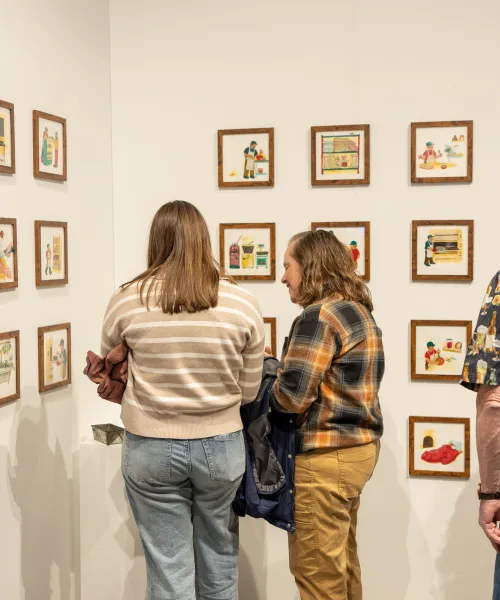Quick Links

About the Program
The Art and Design Education program provides K-12 art teacher certification. Students become confident in teaching and skilled as artists or designers, preparing them for a career as a well-rounded art educator.
The curriculum focuses on current concepts and technology, with students working with various media and concentrating on a studio area of their choice. You'll learn to develop engaging lessons that address contemporary issues and create authentic art-making experiences for students.
Classes include field experiences in local schools, giving you hands-on teaching practice before your final student teaching. As an aspiring art teacher, you'll also have the same studio and exhibition opportunities as other art and design students.
Our graduates have an outstanding record of successful employment in public schools and other art-related fields, including museum education and art administration.
Art Education Faculty
Art Education Courses
AD 248 Introduction to Art Education
4 credit hours
Offered: Offered every third semester. Consult with your adviser for which semester the course will be offered.
Prerequisites: AD 101, AD 270, a minimum grade point average of 2.70 in the department, and admission to a teacher education program. Students must have a portfolio review of previous work.
An introduction to art education and concepts of knowledge, values, and skills with different media in the art classroom. Emphasis is placed on comprehensive art education, audiovisual productions, planning and organizing of an art room and writing lesson plans. A “B” or higher must be earned to take AD 302.
AD 302 Media and Methodology for Art Education
4 credit hours
Offered: Offered every third semester. Consult with adviser for which semester course will be offered.
Prerequisites: Admission into the pre-methods phase of the School of Education, Leadership and Public Service, ED 201, ED 231, ED 301, and AD 248. AD 248 with a minimum grade of “B” and a minimum GPA of 2.7 in the department.
To explore a variety of media used in the art classroom and to gain knowledge, values, and skills in writing comprehensive art education lessons. To implement lesson plans in the schools/museums for practical application.
AD 350 Curriculum Theory and Objectives for Art Education
4 credit hours
Offered: Fall Only
Prerequisite: Admission to the methods phase of teacher education, AD 248 and AD 302 with a minimum grade of “B” and a minimum GPA of 2.70 in the department. Transfer or post-baccalaureate students must have a portfolio of their work approved by the department.
An examination of how the history of art education influences art curricula today. Emphasis is on a written 15-week curriculum, discussion of creative problem solving, discipline, motivation, evaluation, and student-teaching experience.
Note: May not be applied toward a non-teaching major or any minor in art and design. The art education courses listed above must be taken sequentially.
Art Education FAQ
What emphasis will I find in the Art Education Program?
We emphasize a theme-based art education curriculum. You will also find a focus on understanding current meanings in art, in order to create lessons that are fresh and relevant to today’s students. Postmodern art principles and practices, multicultural art, and visual culture are all discussed and used to create your lesson plans.
We use design and studio-based methods to make K-12 art classes a place to develop creative thinking skills that have value to all students, not just those who want to be artists. There is an emphasis on the use of computers to present lessons and the use of digital technology to teach and create exciting projects for K-12 students.
Field experiences are also a big part of the program. You will be out observing and teaching in local K-12 schools every semester of the program.
Will I major in a specific art area like any other art major?
Yes, you will declare your choice of a studio area of concentration, such as ceramics, painting and drawing, photography, or any other area that we offer. Your classes and program in your studio area are structured just as any art major. You will go through the same art review (AD303) and will show work in the senior exhibition. It is the same program and standards as the BFA in art, with additional classes for teacher education.
What are the prospects for employment in art education?
We have a good record of success with our students in getting public school jobs. NMU teacher education has high standards, and our graduating teachers are highly regarded across the country. Employment opportunities are always out there, but will vary in number and location from year to year. A teaching certificate is an excellent credential to have along with your art training, as it shows you are qualified to work with children and have strong human relations skills. This credential is significant to a wide range of employers and supports opportunities in other areas; hospitals, day care centers, assisted living centers, museum education, arts administration, gallery owners, and after-school or weekend art programs are a few of the many options. The certificate proclaims your “people skills” in a big way, which employers will value. And there are job openings for art teachers every year in K-12 schools. NMU graduates have been very successful in getting these jobs.
How long does it take to complete the Art Education program at NMU?
The program requires the most credits of any in Art & Design, as you need the Education classes plus the Art program. The specific requirements can be found in the course bulletin on the NMU website. The program can be completed in 4 ½ academic years (9 semesters), with the final semester being student teaching. Often, students will take 5 years, depending on their individual goals and needs.
Will I need to submit a portfolio for admission?
What kind of computer do I need?
As a student in the School of Art and Design, you will be issued an Apple MacBook laptop computer. The laptop will come with the majority of the required software already loaded. There are four computer labs available for student use as well. The labs are used for instruction, and in some cases, when specific software is unavailable for the laptops, projects must be completed in the labs.
